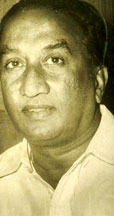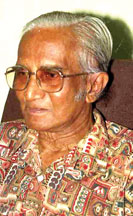 Tagore's imprint Tagore's imprint
By Shireen SENADHIRA
Rabindranath Tagore’s 150th birth anniversary will be on May 6. A
Bengali poet he was. He was no ordinary Bengali poet but a visionary
poet. Such a visionary he was, as to be so inspired that he could
integrate the arts and the human spirit with ecology, economy and also
political and social change.
Tagore was a spiritual poet who was mesmerized by the mystery, beauty
and love of nature in the same vein as Rumi, the well known 13th century
Persian poet and Kabir, the equally famous 15th century Indian poet.
Tagore was able to combine poetic imagination with his social activism.
His poetry and plays were created because of his penchant for
agriculture, education and service to the poor. He was a man who could
be very comfortable working in the fields with farmers and equally so
being at home in his study, writing and painting.
He started a radical school for the poor of his area and such a great
teacher he was, that he told his pupils ‘you have two teachers, myself,
the human teacher and the trees, your nature teacher.’ He held his
classes outdoors, under the spread of trees. He knew that nature was a
more profound source of learning than the printed word. At that time
too, he was a famous playwright and spent so much time with words and
books but he was one who could recognize the limits of the written word.
He immersed himself and his pupils in the experience of the natural
world.
Gandhi called him Gurudev, (the divine teacher). He was called ‘the
greatest son of India,’ by western writers and scientists such as
William Butler Yeats, George Bernard Shaw and Albert Einstein. In his
native Bengal, he was called the ‘Voice of Bengal.’ The former United
Nations Secretary General Javier Perez de Cuellar said he was a ‘a
people’s poet and poet of the world.’ UNESCO declared the year 2011 as
the year of Tagore. He has touched millions of people around the world
with his novels, short stories, plays, paintings, songs and poetry. He
has written more than 1000 poems and over 2000 songs which are still
frequently recited and sung. Rabindranath Tagore was the only Indian to
win the Nobel Prize for Literature for his book of poetry, Gitanjali
which means Song Offerings. He also created the Song of Bengal which was
later adopted as the Indian national anthem. Another well known book of
his is Gora (The Fair Skinned Boy), a novel , and his famous play,
Dakghar (The Post Office). He believed, like his countryman, Jawaharlal
Nehru, that it was the British rule in his country that made all the
races in India to rise in a single voice, to express their view of
freedom which was close to the hearts of the two men. India has a good
reason to be proud of Tagore as his original contribution to art can
stand the comparison with any art in the West.
Influence in Sri Lanka
The interaction between India and Sri Lanka is much because of the
close proximity they have to each other. The distance between the two
countries in the Palk Strait is only 22 miles. It is believed that the
two countries were a single land mass in ancient times which later
split. Therefore, with such an illustrious man of culture, Tagore, being
a close neighbor, it is not surprising that he exerted much influence on
Sri Lankan culture. Many Sri Lankan artists, writers, dancers and
painters were impressed and inspired by the great maestro, Tagore.
Ediriweera Sarachchandra, Sri Lanka’s premier playwright was
influenced by Tagore. While he was in university, Sarachchandra was
lucky to see a ballet performance by Tagore’s Dance Troupe at the Regal
Theatre in Colombo.
The ballet was ‘Saap Mochan,’ (The Curse Redeemed). It was a story
where a disfigured king, Anureshwar who was banished and disfigured for
a misdemeanour in a heavenly court, sends a marriage proposal to the
beautiful princess Kamalika who was banished as well. The proposal
causes much excitement in her palace. It was thus arranged that Kamalika
could only see the king in the dark, but somehow, she persuaded him to
reveal himself. When she saw his disfigurement, with utter shock, she
ran far into the forest and hid herself. Later, on reflection she
realised that the warmth of his love for her, transcended king
Anureshwar’s disfigurement. Then, she returned to him. This generous
gesture on the part of Kamalika lifted the curse of disfigurement from
Anureshwar, revealing his true beauty. Then, all the suffering and
frustrations gave way to love reunited. For a ballet performance, what a
delightful and romantic story to dance to. I can almost visualise it as
I write, with a bevy of beautiful dancers performing the different
scenes.
Awe inspiring
However, exhilarating the performance was, Sarachchandra was mostly
impressed by the great poet, Tagore, seated on stage, keeping tune with
his foot to the rhythm of the music and savouring the pleasure given by
his creation. It must have been awe inspiring to see Tagore in his long
robe and black headgear with his white hair falling on the sides of it
and his white beard flowing on his chest as described by Sarchchandra ,
Wilmot A Perera, a Sri Lankan statesman and a philanthropist was born to
a wealthy family.
 |
 |
| Wilmot A Perera |
Prof. Ediriweera
Sarachchandra |
His father was a rich rubber plantation owner in the Raigam Korale, a
district ensconcing Horana. Wilmot Perera, after his primary and
secondary education wanted to be an archeologist. However, with the
demise of his father, he had no choice but to be a planter and he became
a successful planter within a short time.
As a planter, he had to meet and work with labourers, plantation
staff and other people in the surrounding area. There, he encountered
the grievances of the poor people and the struggle they had to survive.
He made an extensive study to discover the reasons for the hardships. At
the end of the study he wrote a book titled ‘Problems of Rural Society
in the Raigam Korale.’ To find solutions to this question, he
established for the first time a rural development society in the Raigam
area. He also encouraged free education for the children of the poor in
his area.
As a scholarly pursuit, he visited India in the early 1930s. He was
also interested in the freedom struggle in India and Rabindranath
Tagore. After his second visit to India, he had made up his mind to
build a school for the poor with his own funding. Thus the idea of a
school was formed and he invited Tagore to lay the foundation stone of
this school. Wilmot Perera’s dream came true when Tagore laid the
foundation stone of his school on 20 May 1934 during Tagore’s visit to
Sri Lanka for a duration of a month. Tagore even gave the name for this
school, Sri Palee, the place where the goddess of fine arts lives. The
school was modelled on Shantiniketan, Tagore’s own school in West
Bengal. Sri Palee College was located in a beautiful scenic place,
Wewala in Horana. There was much influence of Gurudev, Rabindranth
Tagore, in Sri Palee College. It was fortunate for this college to have
such a relationship with Tagore and not only Tagore’s but Sri Palee
College could get in touch with other prominent Indian personalities of
which some were Pandit Jawaharlal Nehru, Chinthamane Deshmuck,
Wijayalakshmi Pandith, Sarojinee K Naidu, and Sri Sarwarpalli
Radhakrishnan.
It is interesting to know that Wilmot Perera became a founding member
of the Lanka Sama Samaja Party and was active in politics and the
independence movement of Sri Lanka, then Ceylon. He was in the first
post independence parliament. Thereafter he was appointed as the
Ceylonese (Sri Lankan) first ambassador to China in 1957 when Ceylon
established diplomatic ties with the People’s Republic of China. Being a
leftist, he joined the Suriya Mal Movement which was formed in1934
British ruled Ceylon, to sell Suriya flowers on Poppy Day for the
benefit of Sri Lankan ex-servicemen. This movement became an
anti-imperial one. Yearly, until the Second World War, young men and
women sold Suriya flowers on the streets on Armistice Day in competition
with the Poppy sellers and the money collected was used for the Sri
Lankan ex-servicemen. The purchasers of the Suriya flowers were mostly
from the poorer sections of society and the funds collected were not
much. But it became a rallying point for the anti-imperialist youth of
the time. When a drought occurred in 1934-35 during which a mass of
people were affected and many died, the Suriya Mal movement came forward
and worked tirelessly among the poor and the malnourished during the
Malaria epidemic and the later floods. After this performance of the
Movement was over, the funds collected by the sale of flowers were used
to fund the education of students from deprived backgrounds and for
small publications.
Deshamanya Chitrasena, a Sri Lankan ballet star had the good fortune
to study in Tagore’s Fine Arts College, Shantiniketan. He was a past
president of the Tagore Society in Sri Lanka. He recounts that Sri
Lankans always had a special place in their hearts for Gurudev
Rabindranath Tagore and the month long visit in 1934 of Tagore to Sri
Lanka was most memorable as the cultural advancement of our country
received a remarkable stimulus. At that time, Tagore had said, ‘I know
your island and her beauty. I have been here more than once and this
time I have a special mission. I have brought some part of our culture
which Shantiniketan represents. I have brought something from India,
some aspects of the culture, some delight of her arts and I hope you
will realize that it is of eternal value. Politically you may have been
apart from India, but culturally you are part and parcel of India. We
want you to come to us and share our heritage.’ Sir Ivor Jennings, a
former Vice-Chancellor of the University of Ceylon had said ‘Tagore had
more influence than anyone on the revival of the arts in the island. His
love of learning, his deep sense of poetry and his feeling for
literature makes his light a beacon for youth of Ceylon to follow.’ Also
,a reporter at the time of Tagore’s visit said ‘here in Ceylon, Tagore
has kindled a new enthusiasm. He has awakened a great yearning, he has
held aloft a great idealism. It is not this generation that will thank
him for his inspiration to Ceylon. Generations cannot measure the value
of his services. It is not history that will record his achievements.
Even history cannot give a niche to ‘an impetus’ that has opened our
eyes to a vision of the joy and grandeur of our song and music, of our
art and culture.’
Harmony in life
Tagore’s poems, songs, dances, paintings, plays and other writings
and philosophy were the outpourings of an immense creative energy.
Tagore’s gift to mankind was an integral part of his life. It is said
that only a Tagore could have sung ‘Deliverance is not for me in
renunciation. I feel the embrace of freedom in a thousand bonds of
delight.’ Also, ‘And because I love this life, I know I shall love death
as well.’
In his writings, about the object of education, he wrote, ‘the
freedom of mind can only be achieved through the path of freedom,’ and
of the highest education, he wrote, ‘it is that which does not merely
give us information but makes our life in harmony with all existence.’
|

